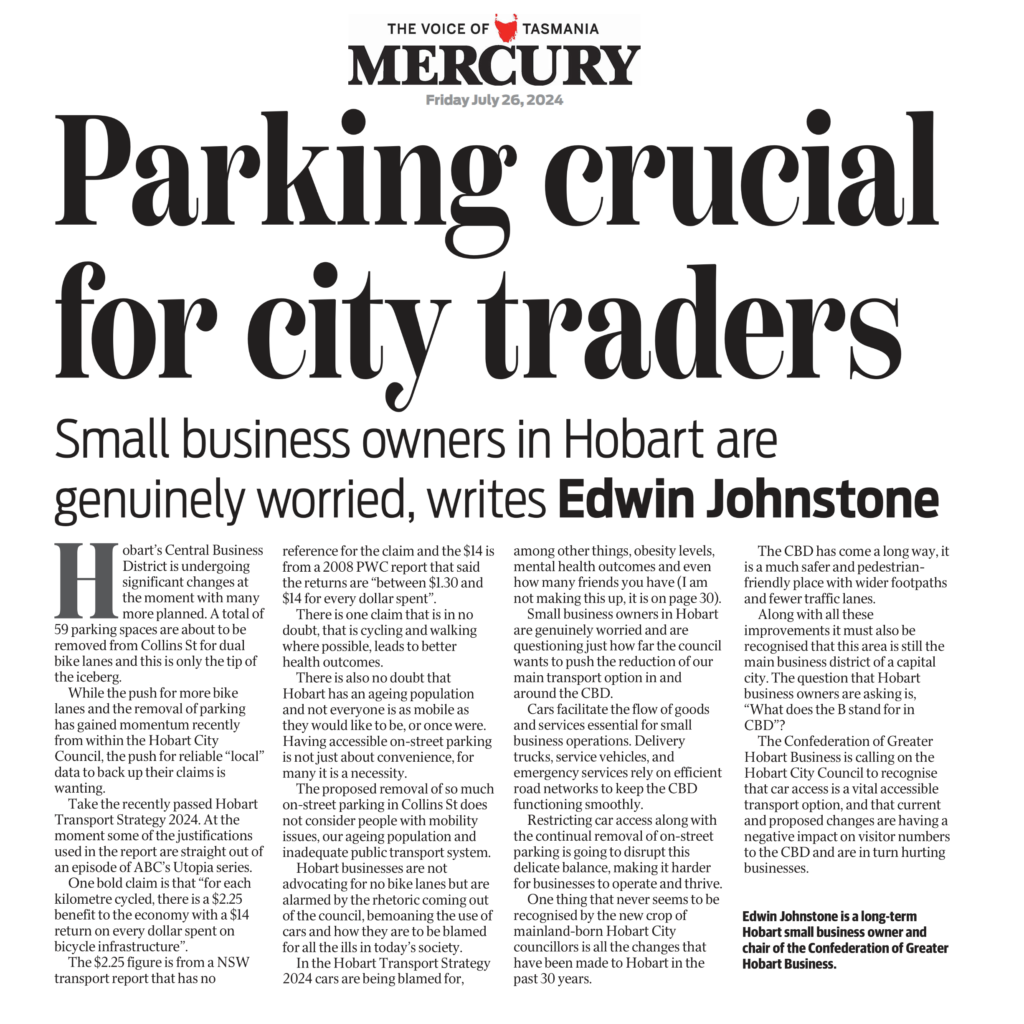
Published: The Mercury 26th July 2024

Hobart’s Central Business District is undergoing significant changes at the moment with many more planned.
A total of 59 parking spaces are about to be removed from Collins St for dual bike lanes and this is only the tip of the iceberg.
While the push for more bike lanes and the removal of parking has gained momentum recently from within the Hobart City Council, the push for reliable “local” data to back up their claims is wanting.
Take the recently passed Hobart Transport Strategy 2024. At the moment some of the justifications used in the report are straight out of an episode of ABC’s Utopia series.
One bold claim is that “for each kilometre cycled, there is a $2.25 benefit to the economy with a $14 return on every dollar spent on bicycle infrastructure”.
The $2.25 figure is from a NSW transport report that has no reference for the claim and the $14 is from a 2008 PWC report that said the returns are “between $1.30 and $14 for every dollar spent”.
There is one claim that is in no doubt, that is cycling and walking where possible, leads to better health outcomes.
There is also no doubt that Hobart has an ageing population and not everyone is as mobile as they would like to be, or once were. Having accessible on-street parking is not just about convenience, for many it is a necessity.
The proposed removal of so much on-street parking in Collins St does not consider people with mobility issues, our ageing population and inadequate public transport system.
Hobart businesses are not advocating for no bike lanes but are alarmed by the rhetoric coming out of the council, bemoaning the use of cars and how they are to be blamed for all the ills in today’s society.
In the Hobart Transport Strategy 2024 cars are being blamed for, among other things, obesity levels, mental health outcomes and even how many friends you have (I am not making this up, it is on page 30).
Small business owners in Hobart are genuinely worried and are questioning just how far the council wants to push the reduction of our main transport option in and around the CBD.
Cars facilitate the flow of goods and services essential for small business operations. Delivery trucks, service vehicles, and emergency services rely on efficient road networks to keep the CBD functioning smoothly.
Restricting car access along with the continual removal of on-street parking is going to disrupt this delicate balance, making it harder for businesses to operate and thrive.
One thing that never seems to be recognised by the new crop of mainland-born Hobart City councillors is all the changes that have been made to Hobart in the past 30 years.
The CBD has come a long way, it is a much safer and pedestrian-friendly place with wider footpaths and fewer traffic lanes.
Along with all these improvements it must also be recognised that this area is still the main business district of a capital city. The question that Hobart business owners are asking is, “What does the B stand for in CBD”?
The Confederation of Greater Hobart Business is calling on the Hobart City Council to recognise that car access is a vital accessible transport option, and that current and proposed changes are having a negative impact on visitor numbers to the CBD and are in turn hurting businesses.
Edwin Johnstone
Chair, Confederation of Greater Hobart Business


